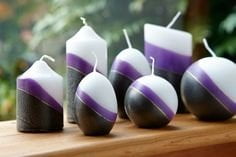Paraffin wax has long been a staple ingredient in the candle making industry. It is widely known for its affordability and availability, making it a popular choice among candle makers. However, there has been an ongoing controversy surrounding the use of paraffin wax in candles.
Critics argue that it poses health risks and contributes to environmental damage. In this article, we will delve into the controversy surrounding paraffin wax in candle making, explore its composition and origins, examine its advantages and downsides, and discuss safety considerations and alternatives. By understanding the different aspects of paraffin wax, readers can make informed decisions about whether it is good for candle making.
Paraffin wax is a petroleum-based wax that is derived from crude oil refining. It comprises a mixture of saturated hydrocarbons, which gives it its characteristic white and odorless properties. The origins of paraffin wax date back to the mid-19th century when it was first commercially produced. Since then, it has become one of the most commonly used waxes in various industries, including cosmetics, pharmaceuticals, and most notably, candle making.
One of the primary advantages of using paraffin wax in candle making is its affordability and availability. Compared to other types of natural waxes or synthetic alternatives, paraffin wax is relatively inexpensive and can be easily obtained. This makes it an attractive choice for both hobbyist candle makers and large-scale manufacturers.
Additionally, paraffin wax has excellent burn characteristics, producing bright flames with minimal soot or smoke when combined with appropriate wicks. These features contribute to its widespread use in commercial candles found on store shelves around the world.
What is Paraffin Wax
Paraffin wax is a popular choice for candle making due to its many desirable properties. In this section, we will delve deeper into the composition and origins of paraffin wax, shedding light on why it is widely used in the industry.
Composition of Paraffin Wax
Paraffin wax is a byproduct of petroleum refining and is derived from crude oil. It is a white or colorless solid that has a low melting point, typically ranging from 130-160 degrees Fahrenheit. The composition of paraffin wax primarily consists of saturated hydrocarbons with carbon chain lengths between 20 and 40. These hydrocarbons give paraffin wax its characteristic properties such as its ability to burn cleanly and evenly.
Origins of Paraffin Wax
The discovery and commercialization of paraffin wax can be traced back to the mid-19th century when it was first obtained as a byproduct in the process of distilling kerosene from petroleum. This newfound substance quickly gained popularity due to its versatility in various applications, including candle making.
Over time, advancements in refining technology enabled the production of highly refined paraffin wax with improved qualities such as reduced odor and increased stability. Today, paraffin wax is produced globally, with major producers including the United States, China, and Germany.
The affordability and availability of paraffin wax make it an attractive option for both commercial candle manufacturers and DIY enthusiasts alike. Its versatility coupled with consistent quality makes it a go-to choice for many candle makers worldwide.
In the next section, we will explore the advantages that make paraffin wax an excellent option for candle making.
The Advantages of Paraffin Wax for Candle Making
Paraffin wax has long been a popular choice for candle making due to its numerous advantages. In this section, we will delve into the two key benefits of paraffin wax: its affordability and availability.
Affordability
One of the primary reasons why paraffin wax is favored by many candle makers is its affordability. Paraffin wax is a byproduct of crude oil refining, which means it is readily available in large quantities and relatively inexpensive. This makes it a cost-effective option for those who are looking to produce candles on a larger scale or within a tight budget.
Moreover, paraffin wax’s affordability doesn’t compromise its quality. It has excellent scent throw capabilities, allowing for the fragrance to disperse effectively when the candle is lit. Additionally, paraffin wax has a low melting point, which means that it can burn more slowly than other waxes, providing longer-lasting burn times for candles.
Availability
In addition to being affordable, paraffin wax is widely available in various forms. Candle makers can easily source paraffin wax from local craft stores or online suppliers. It comes in different types such as pillar blend, container blend, and microcrystalline wax, offering versatility in selecting the ideal type for specific candle-making projects.
Furthermore, paraffin wax is highly compatible with colorants and fragrances. Its ability to hold dyes and scents well allows for creative experimentation in creating vibrantly colored and pleasantly scented candles. This accessibility to a wide range of colors and scents contributes to the popularity of using paraffin wax in candle making.
The Downside of Paraffin Wax
Paraffin wax has long been a popular choice among candle makers due to its affordability and availability. However, there are several concerns surrounding the use of paraffin wax, including its environmental impact and potential health risks. In this section, we will debunk common myths about paraffin wax and address the environmental concerns associated with its use in candle making.
One of the most common misconceptions about paraffin wax is that it releases harmful toxins when burned. While it is true that burning any type of material produces some level of emissions, studies have shown that properly made paraffin candles do not release significant amounts of harmful chemicals into the air. The key factor in reducing emissions is using high-quality paraffin wax and wicks that are properly sized for the candle.
Another myth surrounding paraffin wax is that it is derived from petroleum, making it inherently unsustainable and harmful to the environment. While it is true that paraffin wax is derived from petroleum, it is important to note that much of the petroleum used to produce paraffin wax comes as a byproduct of gasoline production. This means that using paraffin wax can actually help reduce waste as it utilizes a material that would otherwise be discarded.
However, addressing environmental concerns related to paraffin wax in candle making goes beyond its origin. The main concern lies in the fact that unlike other types of candle waxes such as soy or beeswax, paraffin wax is nonrenewable and does not biodegrade easily. This means that discarded paraffin candles contribute to landfill waste and take a long time to break down naturally.
To address these environmental concerns, many candle makers have started exploring alternative waxes such as soy or coconut. These plant-based waxes are renewable, biodegradable, and offer similar performance qualities to paraffin wax. Additionally, some manufacturers are now producing eco-friendly versions of paraffin wax that are made from sustainable sources and have a reduced environmental impact.
| Myth | Debunked |
|---|---|
| Burning paraffin candles releases harmful toxins into the air. | Properly made paraffin candles do not release significant amounts of harmful chemicals. |
| Paraffin wax is derived from petroleum, making it unsustainable and harmful to the environment. | Much of the petroleum used for paraffin wax comes as a byproduct of gasoline production, helping reduce waste. |
| Paraffin wax biodegrades easily or is renewable. | Paraffin wax is nonrenewable and does not biodegrade easily, contributing to landfill waste. |
Safety Considerations
Paraffin wax candles have long been a popular choice for candle making due to their affordability and availability. However, there has been growing concern about the health risks associated with burning paraffin wax candles. In this section, we will explore these safety considerations in order to provide readers with a better understanding of the potential risks involved.
One of the main concerns surrounding paraffin wax candles is the release of potentially harmful chemicals when they are burned. When paraffin wax burns, it can release toxins such as benzene and toluene into the air. These chemicals are known to be respiratory irritants and may pose health risks, especially for those with pre-existing respiratory conditions or sensitivities.
Additionally, the soot produced by burning paraffin wax candles can also be problematic. The black soot that is often seen on walls, ceilings, and furniture is composed of tiny particles that can easily become airborne. Inhalation of these particles can lead to respiratory issues and can also contribute to indoor air pollution.
In comparison, candles made from alternative materials such as soy or beeswax are considered to be safer options. Soy candles produce less soot and do not release toxins when burned. Beeswax candles are another eco-friendly option, as they are all-natural and do not release any harmful chemicals.
It is important for candle makers and consumers alike to be aware of these safety considerations when using paraffin wax candles. Taking necessary precautions such as ensuring proper ventilation and avoiding prolonged exposure to burning candles can help mitigate potential health risks. Additionally, exploring alternative candle-making materials may be a good option for those who prioritize their health and environmental impact.
Data Table: Health Risks Associated with Paraffin Wax Candles
| Health Risk | Description |
|---|---|
| Release of toxic chemicals | Burning paraffin wax candles can release benzene and toluene, respiratory irritants. |
| Potential respiratory issues | Inhalation of soot particles from burning paraffin wax candles can lead to respiratory problems. |
| Indoor air pollution | Soot produced by paraffin wax candles contributes to indoor air pollution. |
Alternatives to Paraffin Wax
Paraffin wax has long been the go-to choice for candle making due to its affordability and availability. However, there has been a growing concern about the environmental impact of using paraffin wax, leading many candle makers to explore alternative options that are more sustainable and eco-friendly. In this section, we will delve into some of the alternatives to paraffin wax that you can consider for your candle making projects.
- Soy Wax: One popular alternative to paraffin wax is soy wax. Made from soybeans, this type of wax is biodegradable and renewable, making it a more environmentally friendly option. Soy wax also has a lower melting point than paraffin wax, which means it burns at a slower pace and provides longer-lasting candles. Additionally, soy wax is known for producing cleaner-burning candles with less soot and smoke.
- Beeswax: Another natural alternative to consider is beeswax. Beeswax is created by bees as they build their honeycombs, making it a sustainable resource when sourced ethically. It has a sweet scent and produces beautiful, golden-hued candles. Beeswax candles are known for their clean burn and ability to purify the air by releasing negative ions when lit.
- Coconut Wax: Derived from coconuts, coconut wax is a renewable and eco-friendly choice for candle making. It has a smooth texture and excellent scent throw capabilities. Coconut wax can blend well with other types of waxes like soy or beeswax to create unique candle creations.
- Palm Wax: While palm oil production often raises concerns about deforestation and habitat destruction, there are sustainable options available such as RSPO-certified palm wax. RSPO certification ensures that the palm oil used in the production of palm wax comes from responsibly managed plantations that do not contribute to deforestation or harm wildlife.
By exploring these alternatives to paraffin wax, you can create candles that are not only beautiful but also more environmentally friendly. It’s important to consider your personal values and priorities when choosing which wax to use, as each option has its own unique qualities and considerations.
Whether you opt for soy wax, beeswax, coconut wax, or RSPO-certified palm wax, making the switch to a sustainable and eco-friendly alternative can enhance your candle making experience while reducing your impact on the planet.
Tips for Using Paraffin Wax in Candle Making
Using paraffin wax in candle making can yield excellent results when done with the right techniques, recipes, and best practices. Whether you are a beginner or experienced candle maker, these tips can help you achieve the desired outcome and enhance your overall candle making experience.
Techniques
- Double Boiler Method: When melting paraffin wax, it is crucial to use a double boiler to prevent direct heat exposure. This method involves placing a heat-resistant container or pouring pitcher filled with wax inside a larger pot filled with water. The water in the pot acts as a buffer, preventing the wax from overheating or catching fire.
- Temperature Control: Maintaining the right temperature is essential for successful candle making with paraffin wax. Use a thermometer to monitor the melting and pouring temperatures recommended for your specific wax type. Pouring at too high or too low temperatures can result in poor adhesion of fragrance oils and an uneven burn.
Recipes
- Adding Fragrance Oils: To create scented candles, add fragrance oils to melted paraffin wax before pouring it into the mold or container. It is recommended to add fragrance oils at a rate of 6-10% of the total weight of the melted wax, depending on your desired scent intensity.
- Creating Colorful Designs: Paraffin wax offers versatility when it comes to adding color to your candles. You can use liquid dyes specifically formulated for candles and mix them into the melted wax until you achieve your desired shade. Experiment with layering different colored waxes or creating unique patterns by pouring multiple layers of differently colored waxes.
Best Practices
- Proper Wick Selection: Choosing the right wick size based on your candle’s diameter is crucial for optimal burning performance. A wick that is too small may result in tunneling, where only the central portion of the candle melts, while a wick that is too large can cause excessive smoke and uneven burning. Consult a wick manufacturer’s guide to determine the best wick size for your candle.
- Cooling and Curing: After pouring the melted paraffin wax into the mold or container, allow it to cool and cure undisturbed for at least 24 hours. This process enhances the fragrance throw and ensures that the wax sets properly, reducing the risk of cracking or frosting.
By following these tips and incorporating them into your candle making process, you can maximize the potential of paraffin wax and create beautiful, high-quality candles. Remember to always prioritize safety measures and experiment with different techniques to develop your own unique style in candle making.
Understanding Consumer Preferences
In the world of candle making, it is essential for candle makers to understand and cater to the preferences of their customers. By analyzing market trends and gathering customer feedback, candle makers can gain valuable insights that can help inform their decisions about using paraffin wax in their candles.
Market trends play a crucial role in understanding consumer preferences. Tracking the popularity of certain types of candles can provide valuable information about what customers are looking for in their candles.
For example, if there is a growing demand for eco-friendly and sustainable candles, it may indicate a shift away from traditional paraffin wax candles toward alternatives like soy or beeswax. On the other hand, if there is still a strong demand for paraffin wax candles, it suggests that consumers are satisfied with the performance and affordability of these candles.
Customer feedback is another valuable source of information for candle makers. By listening to what customers have to say about their experiences with paraffin wax candles, manufacturers can identify areas for improvement or potential concerns. For instance, if customers express worries about the environmental impact of paraffin wax or if they mention safety issues related to its use, these concerns should be taken into consideration in decision making processes.
Candle makers should also keep an eye on emerging trends such as increased interest in natural ingredients, sustainable packaging options, or unique candle designs. Staying up-to-date with market trends allows candle makers to adapt their products and offerings accordingly to meet the evolving demands and preferences of consumers.
By understanding consumer preferences through market trends and customer feedback, candle makers can make informed decisions regarding the use of paraffin wax in their candle-making process. This knowledge allows them to produce candles that not only align with consumer demands but also meet high standards of quality and sustainability. Ultimately, prioritizing consumer preferences helps ensure long-term success in a highly competitive industry.
Conclusion
In conclusion, the controversy surrounding paraffin wax in candle making is a complex issue that requires careful consideration. While paraffin wax has its advantages, such as affordability and availability, it also has downsides and environmental concerns that cannot be ignored. When deciding whether paraffin wax is good for candle making, it is important to weigh these factors and make an informed decision.
One of the main criticisms of paraffin wax is its negative impact on the environment. It is derived from petroleum, a non-renewable resource, and releases harmful toxins when burned. This can contribute to indoor air pollution and have adverse effects on respiratory health. Furthermore, the extraction and processing of petroleum can have detrimental effects on ecosystems and contribute to climate change.
However, it is worth noting that advancements have been made in the candle industry to address these concerns. Many candle makers are now opting for sustainable and eco-friendly alternatives to paraffin wax, such as soy wax or beeswax. These options offer a more sustainable choice for those conscious of their environmental footprint.
Ultimately, whether paraffin wax is good for candle making depends on individual preferences and priorities. Some may prioritize affordability and availability, while others may prioritize sustainability and environmental impact. By considering the advantages and disadvantages of paraffin wax, exploring alternative options, and understanding consumer preferences, individuals can make an informed decision that aligns with their values and meets their desired outcomes in candle making.
Frequently Asked Questions
Which is better soy wax or paraffin wax?
When it comes to determining which is better between soy wax and paraffin wax, it largely depends on personal preferences and priorities. Soy wax is considered a more environmentally-friendly choice as it is derived from renewable resources, namely soybeans. It burns more cleanly, producing less soot and toxins compared to paraffin wax. Additionally, soy wax has a lower melting point, meaning it takes less time to melt and results in longer burning hours for candles.
On the other hand, paraffin wax is widely available and easily accessible, making it a popular choice for candle-making. It tends to have a higher scent throw, meaning the fragrance of the candle is released more strongly while burning compared to soy wax candles. Ultimately, determining which wax is better boils down to individual preferences regarding environmental impact and scent throw.
Is it safe to make candles with paraffin wax?
Making candles with paraffin wax can be safe if proper precautions are taken. However, it’s important to note that burning paraffin wax candles releases small amounts of potentially harmful substances such as benzene and toluene into the air, which can contribute to indoor air pollution when burned excessively or in poorly ventilated areas. To minimize potential health risks associated with paraffin candles, ensure you purchase high-quality paraffin wax from reputable suppliers that follow strict manufacturing standards.
It is crucial to read and follow the instructions provided by candle-making suppliers for safe handling practices during melting and pouring of the hot wax. Additionally, maintaining good ventilation by burning candles in well-ventilated areas can help reduce any potential health effects associated with paraffin candle usage.
Should I use paraffin or soy wax for candles?
Deciding whether to use paraffin or soy wax for your candles depends primarily on your specific requirements and priorities as a candle-maker. Paraffin wax has been a standard choice for many decades due to its ease of use, affordability, wide availability, strong scent throw when burnt, and ability to hold shape well when creating different candle designs. On the other hand, soy wax is a more environmentally-friendly alternative as it is derived from renewable resources and burns cleaner, emitting less soot and toxins into the air. Soy wax also tends to have a longer burning time due to its lower melting point.
If you prioritize sustainability and cleaner burning candles, soy wax may be the preferred option. However, if scent throw and ease of use are more important, paraffin wax may be the better choice for you. Ultimately, it’s crucial to weigh the pros and cons of each type of wax based on your priorities before making a decision.

Welcome to my candle making blog! In this blog, I will be sharing my tips and tricks for making candles. I will also be sharing some of my favorite recipes.





